Introduction to statistics and probability
Contents
# Install the necessary dependencies
import sys
import numpy as np
import pandas as pd
import matplotlib.pyplot as plt
!{sys.executable} -m pip install --quiet pandas numpy matplotlib jupyterlab_myst pygments
4.4. Introduction to statistics and probability#
Statistics and Probability Theory are two highly related areas of Mathematics that are highly relevant to Data Science. It is possible to operate with data without deep knowledge of mathematics, but it is still better to know at least some basic concepts. Here we will present a short introduction that will help you get started.
from IPython.display import HTML
display(
HTML(
"""
<div class="yt-container">
<iframe width="560" height="315" src="https://www.youtube.com/embed/Z5Zy85g4Yjw" title="YouTube video player" frameborder="0" allow="accelerometer; autoplay; clipboard-write; encrypted-media; gyroscope; picture-in-picture" allowfullscreen></iframe>
</div>
"""
)
)
execute: exclude_patterns: - ‘assignments/’ - ‘assignments/**/’ - ‘deep-learning/’ - ‘slides/’ - ‘slides/**/*’ - ‘ml-fundamentals/classification/introduction-to-classification.md’ - ‘ml-fundamentals/build-a-web-app-to-use-a-machine-learning-model.md’ - ‘ml-fundamentals/regression/managing-data.md’ - ‘ml-fundamentals/parameter-optimization/loss-function.md’ - ‘ml-advanced/ensemble-learning/random-forest.md’ - ‘ml-advanced/clustering/introduction-to-clustering.md’ - ‘ml-advanced/clustering/k-means-clustering.md’ - ‘ml-advanced/unsupervised-learning.md’ - ‘data-science/data-visualization/visualization-distributions.md’
4.4.1. Probability and random variables#
Probability is a number between 0 and 1 that expresses how probable an event is. It is defined as a number of positive outcomes (that lead to the event), divided by a total number of outcomes, given that all outcomes are equally probable. For example, when we roll a dice, the probability that we get an even number is \(3/6 = 0.5\).
When we talk about events, we use random variables. For example, the random variable that represents a number obtained when rolling a dice would take values from \(1\) to \(6\). A set of numbers from \(1\) to \(6\) is called sample space. We can talk about the probability of a random variable taking a certain value, for example, \(P(X=3)=1/6\).
The random variable in the previous example is called discrete because it has a countable sample space, i.e. there are separate values that can be enumerated. There are cases when sample space is a range of real numbers or the whole set of real numbers. Such variables are called continuous. A good example is a time when the bus arrives.
4.4.2. Probability distribution#
In the case of discrete random variables, it is easy to describe the probability of each event by a function \(P(X)\). For each value \(s\) from sample space \(S\) it will give a number from \(0\) to \(1\), such that the sum of all values of \(P(X=s)\) for all events would be \(1\).
The most well-known discrete distribution is a uniform distribution, in which there is a sample space of \(N\) elements, with an equal probability of \(1/N\) for each of them.
It is more difficult to describe the probability distribution of a continuous variable, with values drawn from some interval \([a,b]\), or the whole set of real numbers \(\mathbb{R}\). Consider the case of bus arrival time. In fact, for each exact arrival time \(t\), the probability of a bus arriving at exactly that time is \(0\)!
Note
Now you know that events with \(0\) probability happen, and very often! At least each time when the bus arrives!
We can only talk about the probability of a variable falling in a given interval of values, eg. \(P(t_1 \le X < t_2)\). In this case, the probability distribution is described by a probability density function p(x), such that
A continuous analog of uniform distribution is called continuous uniform, which is defined on a finite interval. A probability that the value \(X\) falls into an interval of length \(l\) is proportional to \(l\), and rises to \(1\).
Another important distribution is normal distribution, which we will talk about in more detail below.
4.4.3. Mean, variance and standard deviation#
Suppose we draw a sequence of n samples of a random variable \(X: x_1, x_2, ..., x_n\). We can define the mean (or arithmetic average) value of the sequence in the traditional way as \((x_1+x_2+x_n)/n\). As we grow the size of the sample (i.e. take the limit with \(n\to\infty\)), we will obtain the mean (also called expectation) of the distribution. We will denote expectation by \(E(x)\).
Note
It can be demonstrated that for any discrete distribution with values \(\{x_1, x_2, ..., x_N\}\) and corresponding probabilities \(p_1, p_2, ..., p_N\), the expectation would equal to \(E(X)=x_1p_1+x_2p_2+...+x_Np_N\).
To identify how far the values are spread, we can compute the variance \(\sigma^2 = \sum(x_i - \mu;)^2/n\), where \(\mu\) is the mean of the sequence. The value \(\sigma\) is called standard deviation, and \(\sigma^2\) is called a variance.
4.4.4. Mode, median and quartiles#
Sometimes, the mean does not adequately represent the “typical” value for data. For example, when there are a few extreme values that are completely out of range, they can affect the mean. Another good indication is a median, a value such that half of the data points are lower than it, and another half - higher.
To help us understand the distribution of data, it is helpful to talk about quartiles:
the first quartile, or \(Q1\), is a value, such that \(25%\) of the data fall below it,
the third quartile, or \(Q3\), is a value that \(75%\) of the data falls below it.
Graphically we can represent the relationship between the median and quartiles in a diagram called the box plot:
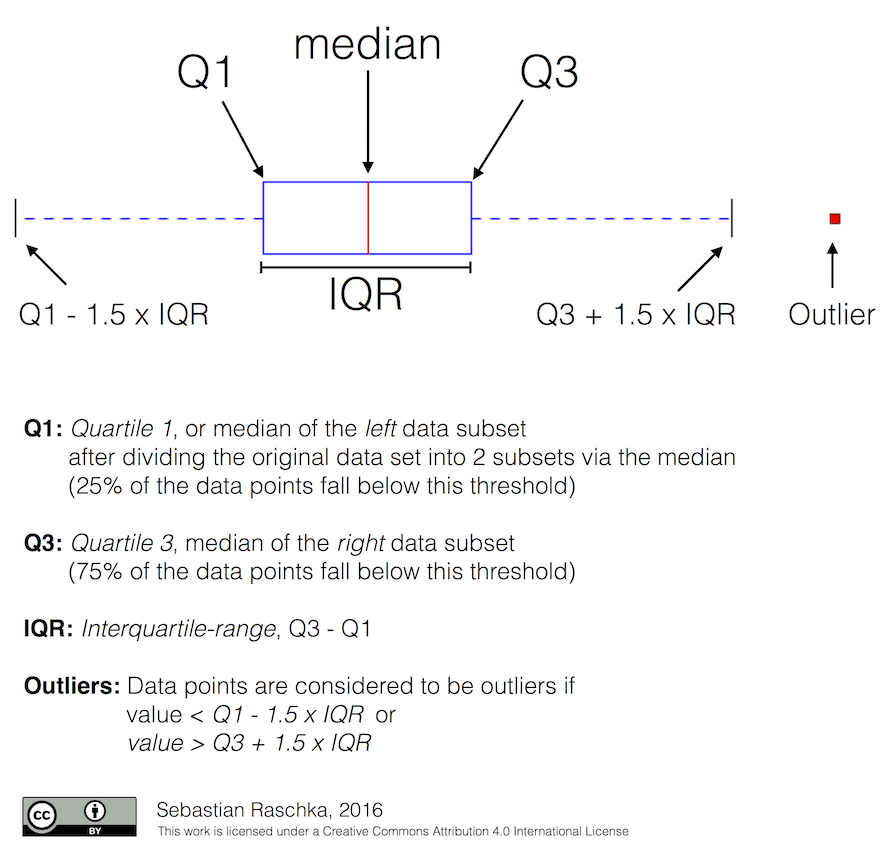
Here we also compute the inter-quartile range \(IQR=Q3-Q1\), and so-called outliers - values, that lie outside the boundaries \([Q1-1.5*IQR, Q3+1.5*IQR]\).
For the finite distribution that contains a small number of possible values, a good “typical” value is the one that appears the most frequently, which is called mode. It is often applied to categorical data, such as colors. Consider a situation where we have two groups of people - some that strongly prefer red, and others who prefer blue. If we code colors by numbers, the mean value for a favorite color would be somewhere in the orange-green spectrum, which does not indicate the actual preference for either group. However, the mode would be either one of the colors, or both colors, if the number of people voting for them is equal (in this case we call the sample multimodal).
4.4.5. Real-world data#
When we analyze data from real life, they often are not random variables as such, in the sense that we do not perform experiments with unknown results. For example, consider a team of baseball players, and their body data, such as height, weight and age. Those numbers are not exactly random, but we can still apply the same mathematical concepts. For example, a sequence of people’s weights can be considered to be a sequence of values drawn from some random variable. Below is the sequence of weights of actual baseball players from Major League Baseball, taken from this dataset (for your convenience, only the first 20 values are shown):
[180.0, 215.0, 210.0, 210.0, 188.0, 176.0, 209.0, 200.0, 231.0, 180.0, 188.0, 180.0, 185.0, 160.0, 180.0, 185.0, 197.0, 189.0, 185.0, 219.0]
[180.0,
215.0,
210.0,
210.0,
188.0,
176.0,
209.0,
200.0,
231.0,
180.0,
188.0,
180.0,
185.0,
160.0,
180.0,
185.0,
197.0,
189.0,
185.0,
219.0]
Note
To see the example of working with this dataset, have a look at the accompanying notebook. There are also a number of challenges throughout this section, and you may complete them by adding some code to that notebook. If you are not sure how to operate on data, do not worry - we will come back to working with data using Python at a later time. If you do not know how to run code in Jupyter Notebook, have a look at this article.
Here is the box plot showing the mean, median, and quartiles for our data:

Since our data contains information about different player roles, we can also do the box plot by role - it will allow us to get an idea on how parameter values differ across roles. This time we will consider height:
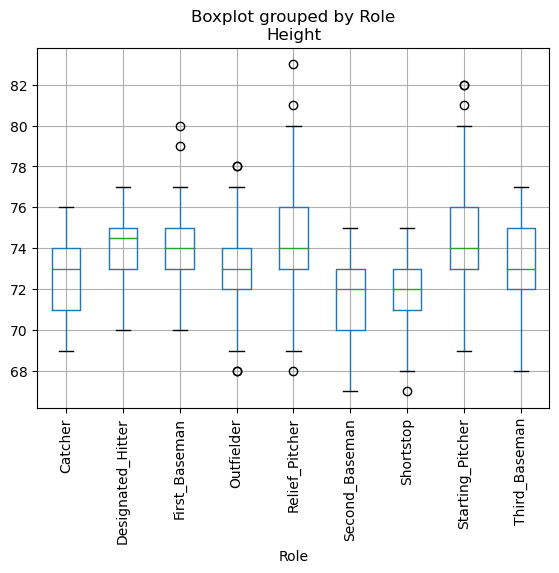
This diagram suggests that, on average, the height of first basemen is higher than the height of second basemen. Later in this section, we will learn how we can test this hypothesis more formally, and how to demonstrate that our data is statistically significant to show that.
Note
When working with real-world data, we assume that all data points are samples drawn from some probability distribution. This assumption allows us to apply machine learning techniques and build working predictive models.
To see what the distribution of our data is, we can plot a graph called a histogram. The X-axis would contain a number of different weight intervals (so-called bins), and the vertical axis would show the number of times our random variable sample was inside a given interval.
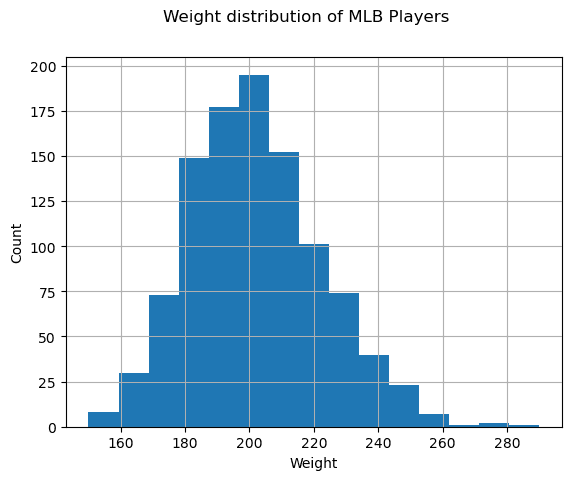
From this histogram, you can see that all values are centered around a certain mean weight, and the further we go from that weight - the fewer weights of that value are encountered. I.e., it is very improbable that the weight of a baseball player would be very different from the mean weight. The variance of weights shows the extent to which weights are likely to differ from the mean.
Note
If we take weights of other people, not from the baseball league, the distribution is likely to be different. However, the shape of the distribution will be the same, but mean and variance would change. So, if we train our model on baseball players, it is likely to give wrong results when applied to students of a university, because the underlying distribution is different.
4.4.6. Normal distribution#
The distribution of weights that we have seen above is very typical, and many measurements from the real world follow the same type of distribution, but with different mean and variance. This distribution is called normal distribution, and it plays a very important role in statistics.
Using normal distribution is the correct way to generate random weights of potential baseball players. Once we know the mean weight mean and standard deviation std, we can generate 1000 weight samples in the following way:
from statistics import mean
mean = 10
std = 2
samples = np.random.normal(mean, std, 1000)
samples[:20]
array([ 8.5079555 , 8.54765597, 10.18784585, 9.73683373, 12.48280595,
9.63161881, 5.1694744 , 8.0718017 , 10.19794036, 11.79017814,
9.03864753, 11.10922021, 10.11707525, 8.73917863, 12.60307804,
8.78253667, 7.04982881, 9.15271519, 10.562848 , 10.94202637])
If we plot the histogram of the generated samples we will see a picture very similar to the one shown above. And if we increase the number of samples and the number of bins, we can generate a picture of a normal distribution that is more close to ideal:
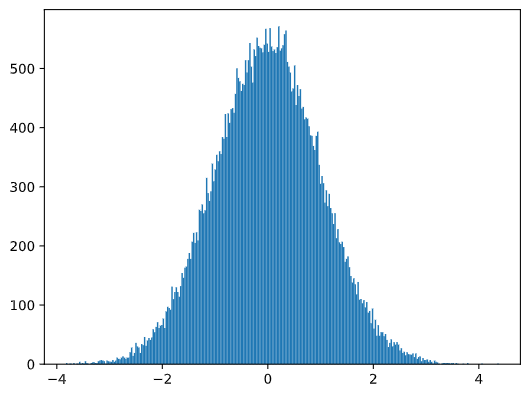
Fig. 4.5 Normal distribution with \(mean=0\) and \(std.dev=1\)#
4.4.7. Confidence intervals#
When we talk about the weights of baseball players, we assume that there is a certain random variable \(W\) that corresponds to the ideal probability distribution of weights of all baseball players (so-called population). Our sequence of weights corresponds to a subset of all baseball players that we call sample. An interesting question is, can we know the parameters of the distribution of \(W\), i.e. mean and variance of the population?
The easiest answer would be to calculate the mean and variance of our sample. However, it could happen that our random sample does not accurately represent the complete population. Thus it makes sense to talk about confidence interval.
Note
Confidence interval is the estimation of true mean of the population given our sample, which is accurate is a certain probability (or level of confidence).
Suppose we have a sample \(X_1, ..., X_n\) from our distribution. Each time we draw a sample from our distribution, we would end up with a different mean value \(\mu\). Thus \(\mu\) can be considered to be a random variable. A confidence interval with confidence \(p\) is a pair of values \((L_p,R_p)\), such that \(P(L_p\le\mu\le R_p) = p\), i.e. a probability of the measured mean value falling within the interval equals \(p\).
It does beyond our short intro to discuss in detail how those confidence intervals are calculated. Some more details can be found on Wikipedia. In short, we define the distribution of the computed sample mean relative to the true mean of the population, which is called student distribution.
Note
Interesting fact: Student distribution is named after mathematician William Sealy Gosset, who published his paper under the pseudonym “Student”. He worked in the Guinness brewery, and, according to one of the versions, his employer did not want general public to know that they were using statistical tests to determine the quality of raw materials.
If we want to estimate the mean \(\mu\); of our population with confidence \(p\), we need to take \((1-p)/2\)-th percentile of a student distribution \(A\), which can either be taken from tables or computer using some built-in functions of statistical software (eg. Python, R, etc.). Then the interval for \(\mu\); would be given by \(X\pm A*D/\sqrt{n}\), where \(X\) is the obtained mean of the sample, and \(D\) is the standard deviation.
Note
We also omit the discussion of an important concept of degrees of freedom, which is important in relation to student distribution. You can refer to more complete books on statistics to understand this concept deeper.
An example of calculating the confidence interval for weights and heights is given in the accompanying notebooks.
p |
Weight mean |
|---|---|
0.85 |
201.73±0.94 |
0.90 |
201.73±1.08 |
0.95 |
201.73±1.28 |
Notice that the higher the confidence probability, the wider the confidence interval.
4.4.8. Hypothesis testing#
In our baseball players dataset, there are different player roles, that can be summarized below (look at the accompanying notebooks) to see how this table can be calculated):
Role |
Height |
Weight |
Count |
|---|---|---|---|
Catcher |
72.723684 |
204.328947 |
76 |
Designated_Hitter |
74.222222 |
220.888889 |
18 |
First_Baseman |
74.000000 |
213.109091 |
55 |
Outfielder |
73.010309 |
199.113402 |
194 |
Relief_Pitcher |
74.374603 |
203.517460 |
315 |
Second_Baseman |
71.362069 |
184.344828 |
58 |
Shortstop |
71.903846 |
182.923077 |
52 |
Starting_Pitcher |
74.719457 |
205.163636 |
221 |
Third_Baseman |
73.044444 |
200.955556 |
45 |
We can notice that the mean heights of first basemen are higher than that of second basemen. Thus, we may be tempted to conclude that first basemen are higher than second basemen.
Note
This statement is called a hypothesis, because we do not know whether the fact is actually true or not.
However, it is not always obvious whether we can make this conclusion. From the discussion above we know that each mean has an associated confidence interval, and thus this difference can just be a statistical error. We need a more formal way to test our hypothesis.
Let’s compute confidence intervals separately for heights of first and second basemen:
Confidence |
First Basemen |
Second Basemen |
|---|---|---|
0.85 |
73.62…74.38 |
71.04…71.69 |
0.90 |
73.56…74.44 |
70.99…71.73 |
0.95 |
73.47…74.53 |
70.92…71.81 |
We can see that under no confidence the intervals overlap. That proves our hypothesis that first basemen are higher than second basemen.
More formally, the problem we are solving is to see if two probability distributions are the same or at least have the same parameters. Depending on the distribution, we need to use different tests for that. If we know that our distributions are normal, we can apply the student t-test.
In the student t-test, we compute the so-called t-value, which indicates the difference between means, taking into account the variance. It is demonstrated that the t-value follows student distribution, which allows us to get the threshold value for a given confidence level \(p\) (this can be computed, or looked up in the numerical tables). We then compare the t-value to this threshold to approve or reject the hypothesis.
In Python, we can use the SciPy package, which includes ttest_ind function (in addition to many other useful statistical functions!). It computes the t-value for us, and also does the reverse lookup of the confidence p-value, so that we can just look at the confidence to draw the conclusion.
For example, our comparison between the heights of first and second basemen gives us the following results:
df = pd.read_csv("https://static-1300131294.cos.ap-shanghai.myqcloud.com/data/SOCR_MLB.tsv",
sep='\t', header=None, names=['Name', 'Team', 'Role', 'Height', 'Weight', 'Age'])
df
from scipy.stats import ttest_ind
tval, pval = ttest_ind(
df.loc[df['Role'] == 'First_Baseman',
['Height']],
df.loc[df['Role'] == 'Designated_Hitter',
['Height']],
equal_var=False
)
print(f"T-value = {tval[0]:.2f}\nP-value: {pval[0]}")
T-value = -0.44
P-value: 0.6594504178995297
#T-value = 7.65
T_value = 7.65
print(f"T-value: {T_value:}")
#P-value: 9.137321189738925e-12
P_value = 9.137321189738925e-12
print(f"P-value: {P_value:.15e}")
T-value: 7.65
P-value: 9.137321189738925e-12
In our case, the p-value is very low, meaning that there is strong evidence supporting that the first basemen are taller.
There are also different other types of hypotheses that we might want to test, for example:
To prove that a given sample follows some distribution. In our case, we have assumed that heights are normally distributed, but that needs formal statistical verification.
To prove that a mean value of a sample corresponds to some predefined value.
To compare means of a number of samples (eg. what is the difference in happiness levels among different age groups).
4.4.9. Law of large numbers and central limit theorem#
One of the reasons why normal distribution is so important is the so-called central limit theorem. Suppose we have a large sample of independent \(N\) values \(X_1, ..., X_N\), sampled from any distribution with mean \(\mu\) and variance \(\sigma^2\). Then, for sufficiently large \(N\) (in other words, when \(N\to\infty\)), the mean \(\Sigma_iX_i\) would be normally distributed, with mean \(\mu\) and variance \(\sigma^2/N\).
Note
Another way to interpret the central limit theorem is to say that regardless of distribution, when you compute the mean of a sum of any random variable values you end up with normal distribution.
From the central limit theorem, it also follows that when \(N\to\infty\), the probability of the sample mean to be equal to \(\mu\) becomes \(1\). This is known as the law of large numbers.
4.4.10. Covariance and correlation#
One of the things Data Science does is find relations between data. We say that two sequences correlate when they exhibit similar behavior at the same time, i.e. they either rise/fall simultaneously, or one sequence rises when another one falls and vice versa. In other words, there seems to be some relation between the two sequences.
Note
Correlation does not necessarily indicate causal relationship between two sequences; sometimes both variables can depend on some external cause, or it can be purely by chance the two sequences correlate. However, strong mathematical correlation is a good indication that two variables are somehow connected.
Mathematically, the main concept that shows the relation between two random variables is covariance, which is computed like this: \(Cov(X, Y) = E[(X-E(X))(Y-E(Y))]\). We compute the deviation of both variables from their mean values, and then the product of those deviations. If both variables deviate together, the product would always be a positive value, which would add up to positive covariance. If both variables deviate out of sync (i.e. one falls below average when another one rises above average), we will always get negative numbers, which will add up to negative covariance. If the deviations are not dependent, they will add up to roughly zero.
The absolute value of covariance does not tell us much about how large the correlation is, because it depends on the magnitude of actual values. To normalize it, we can divide covariance by the standard deviation of both variables, to get a correlation. The good thing is that correlation is always in the range of \([-1,1]\), where \(1\) indicates a strong positive correlation between values, \(-1\) - strong negative correlation, and \(0\) - no correlation at all (variables are independent).
Example: we can compute the correlation between weights and heights of baseball players from the dataset mentioned above:
heights = df['Height']
weights = df['Weight']
print(np.corrcoef(weights, heights))
[[nan nan]
[nan 1.]]
As a result, we get the correlation matrix like this one:
a = np.array([[1. , 0.52959196],
[0.52959196, 1. ]])
a
array([[1. , 0.52959196],
[0.52959196, 1. ]])
Note
Correlation matrix \(C\) can be computed for any number of input sequences \(S_1, ..., S_n\). The value of \(C_{ij}\) is the correlation between \(S_i\) and \(S_j\), and diagonal elements are always \(1\) (which is also self-correlation of \(S_i\)).
In our case, the value \(0.53\) indicates that there is some correlation between the weight and height of a person. We can also make the scatter plot of one value against the other to see the relationship visually:
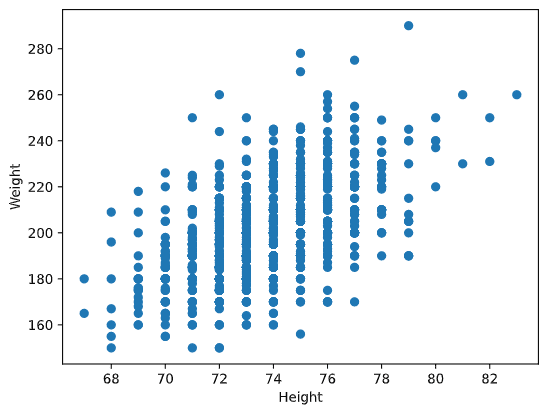
Note
More examples of correlation and covariance can be found in accompanying notebook.
4.4.11. Conclusion#
In this section, we have learned:
basic statistical properties of data, such as mean, variance, mode, and quartiles,
different distributions of random variables, including normal distribution,
how to find the correlation between different properties,
how to use sound apparatus of math and statistics in order to prove some hypotheses,
how to compute confidence intervals for a random variable given data sample.
While this is definitely not an exhaustive list of topics that exist within probability and statistics, it should be enough to give you a good start on this course.
4.4.12. Your turn! 🚀#
Use the sample code in the notebook to test another hypothesis:
First basemen are older than second basemen
First basemen are taller than third basemen
Shortstops are taller than second basemen
4.4.13. Self study#
Probability and statistics are such a broad topic that it deserves their own course. If you are interested to go deeper into theory, you may want to continue reading some of the following books:
Carlos Fernandez-Granda from New York University has great lecture notes Probability and Statistics for Data Science (available online)
Peter and Andrew Bruce. Practical Statistics for Data Scientists. [sample code in R].
James D. Miller. Statistics for Data Science [sample code in R]
4.4.14. Acknowledgments#
Thanks to Microsoft for creating the open-source course Data Science for Beginners. It inspires the majority of the content in this chapter.


